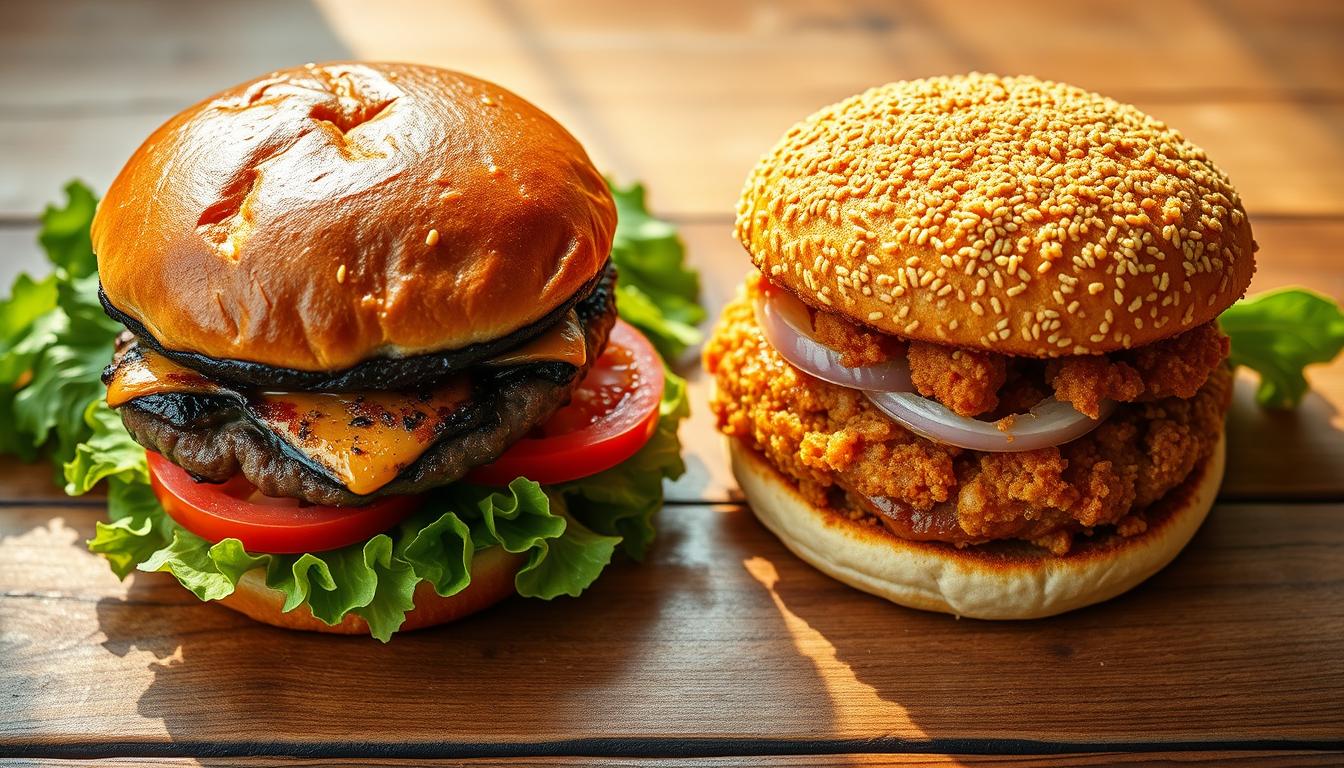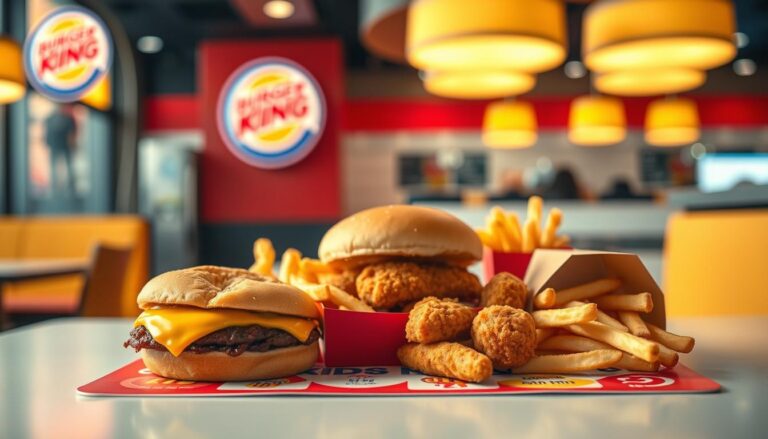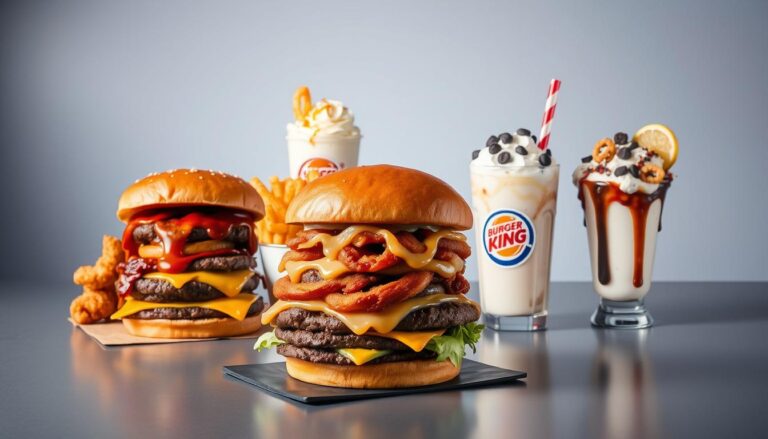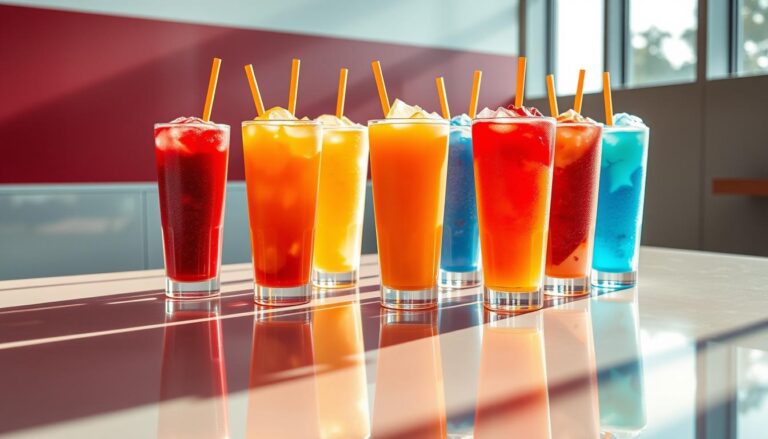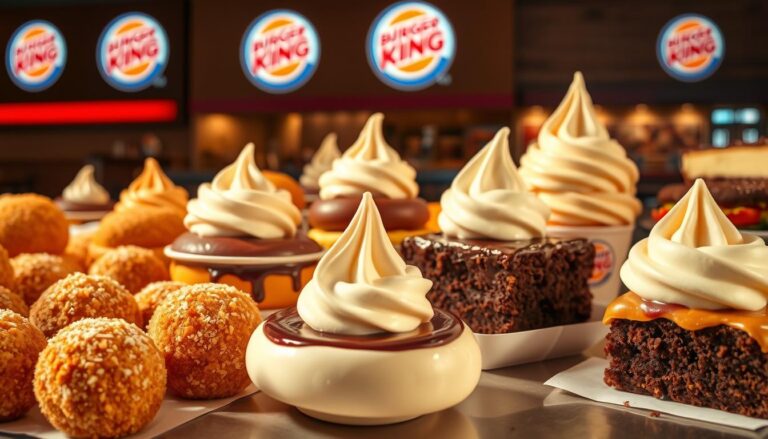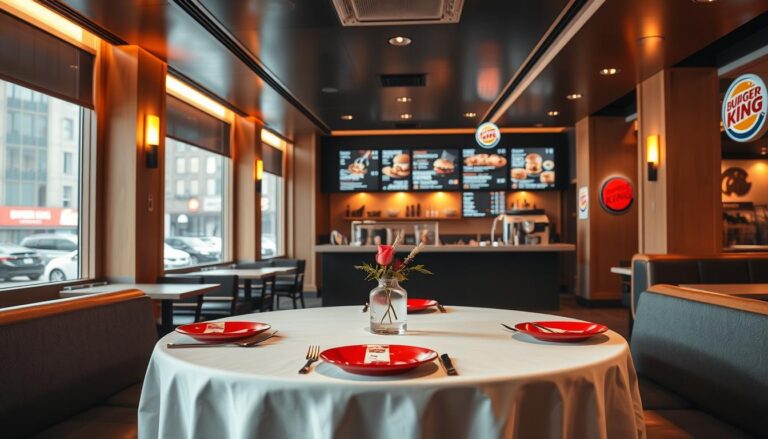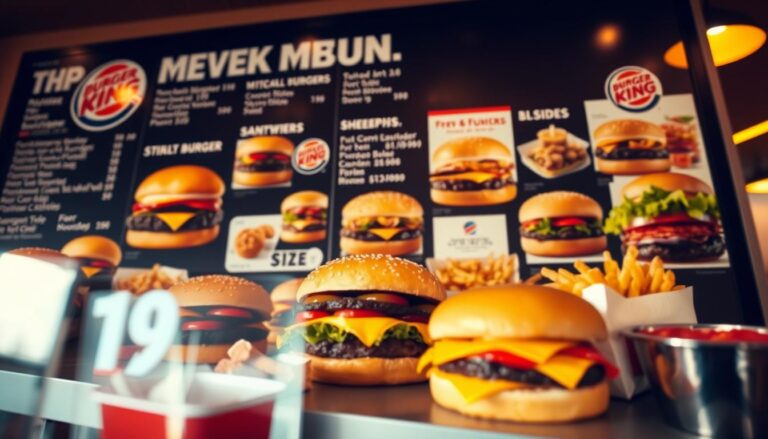Flame Grilled or Fried Burger: Which Tastes Best?
Every burger lover faces a big choice: flame grilled or fried? Your choice can change your meal completely. Experts at Consumer Reports found out how cooking affects taste, texture, and quality.
The debate over flame grilled vs fried burgers is intense. Each method adds special qualities that make your burger stand out. Some places focus on one method, making their burgers famous.
Places like Five Guys and Burger King use different ways to cook. Flame grilled burgers have smoky flavors and char marks. Pan-fried burgers are caramelized and cooked evenly. It’s all about what you like better.
Chefs know cooking method is key to a great burger. It’s about controlling temperature and how the meat reacts. Knowing this helps pick the best burger.
Food lovers enjoy the science behind cooking burgers. The Maillard reaction, a chemical process, changes flavor differently for each method. This makes your burger taste amazing.
Exploring how burgers are made shows interesting facts. Whether you like the smoky taste of flame grilling or the even cooking of frying, each has its perks. Kitchens choose carefully to please their customers.
Knowing about cooking helps you choose your next burger wisely. From home grills to professional kitchens, the debate over flame grilled vs fried burgers is exciting for everyone in the U.S.
The Great Burger Debate: Understanding Cooking Methods
Burger lovers have always argued over the best way to cook them. Flame grilled burgers and fried burgers each offer something special. They create different tastes that make our mouths water.
How you cook a burger is key to making it great. The cooking method changes the burger’s taste, texture, and how it feels to eat.
Traditional Cooking Techniques Explored
Professional chefs mainly use two ways to cook burgers:
- Flame grilling: Direct heat from open flames
- Pan frying: Cooking on a flat surface with controlled heat
Heat Distribution Dynamics
Each cooking method has its own way of spreading heat. Flame grilled burgers get a smoky flavor from direct fire. Fried burgers get a crispy outside from even pan heat.
| Cooking Method | Heat Type | Flavor Profile |
|---|---|---|
| Flame Grilling | Direct Flame | Smoky, Charred |
| Pan Frying | Consistent Surface | Crispy, Caramelized |
Temperature Control Insights
Controlling the temperature is what makes a good cook great. Flame grilled burgers need careful flame watching. Fried burgers need a steady pan temperature for the perfect doneness.
Knowing these cooking details helps home cooks make better burgers. It ensures a delicious burger every time.
Flame Grilled vs Fried Burger Menu: A Comparative Analysis
Looking into burger menus shows us how flame grilled and fried burgers differ. These options are more than just meat; they’re about rich flavors that make burgers special.
Today’s premium burgers come in many cooking styles. Flame grilling adds a smoky taste that fans love. On the other hand, frying gives a crispy outside and a juicy inside.
- Flame Grilled Burgers:
- Enhanced smoky flavor profile
- Natural char marks
- Leaner cooking method
- Fried Burgers:
- Crispy exterior
- More controlled cooking environment
- Consistent heat distribution
Chefs and home cooks know each method has its own charm. Flame grilling is great for beef, making those perfect edges. Pan-frying, like in cast iron skillets, is perfect for all kinds of patties.
Knowing about these cooking ways helps us choose better from the menu. Whether you like the bold taste of flame-grilled burgers or the exact cooking of fried ones, each way is a unique journey.
The Science Behind Flame Grilling
Flame grilled burgers are a true masterpiece in cooking. They offer a flavor that’s unmatched by fried burgers. Knowing the science behind flame grilling can make your burgers truly stand out.
Maillard Reaction: The Flavor Transformation
The Maillard reaction is key to flame grilled burgers. It happens when proteins and sugars meet high heat. This process creates the brown crust and deep flavors that make these burgers so loved.
- Occurs at temperatures between 285-330°F
- Produces hundreds of different flavor compounds
- Creates the signature golden-brown exterior
Smoke Infusion: Adding Depth to Flavor
Flame grilling also adds a special smoke flavor. This flavor comes from the meat juices and flames. It’s something frying can’t match.
Precision Temperature Management
Getting great flame grilled burgers needs careful heat control. Chefs know that even heat is key for the perfect burger. The best grilling temperature is between 400-450°F. This ensures a tasty outside and juicy inside.
Whether you’re looking at flame grilled vs fried burgers or just want the best, knowing these science facts will change how you cook.
Pan-Frying Techniques for Perfect Burgers
Mastering fried burgers needs precision and skill. The pan-frying method is great for home cooks. It lets them make delicious burgers like restaurants. Unlike grilling, skillet cooking gives more control over heat and flavor.
Professional chefs say a few key techniques are essential for the perfect pan-fried burger:
- Select a heavy-bottomed cast iron skillet for even heat distribution
- Use high-smoke-point oils like avocado or grapeseed
- Ensure meat is at room temperature before cooking
- Season generously with salt and pepper
The secret to amazing fried burgers is managing heat. Preheat your skillet to medium-high for a perfect sear. Press a slight dimple in the burger’s center to prevent bulging during cooking. This ensures an evenly cooked patty with a crispy exterior.
Different burger menu options need slightly different approaches. Leaner meats need careful monitoring to prevent drying out. Higher fat content burgers get a more robust crust. Try different cooking times and temperatures to find your perfect method.
Professional tip: Use a meat thermometer to check internal temperature. Medium-rare burgers should be 135°F, while well-done ones are 160°F. Always let your burger rest for 3-5 minutes after cooking. This lets the juices redistribute and makes the burger even more delicious.
Texture Comparison: Grilled vs. Fried Patties
Burger lovers know that how you cook it changes everything. The choice between flame grilled and fried burgers gives you two different textures. Knowing these differences helps you pick the perfect patty for your meal.
Looking at the burger menu, you’ll see how grilling and frying change a patty’s feel. Each way makes the burger’s outside and inside different. It turns a simple patty into a special dish.
Crust Formation Dynamics
Grilled burgers get a unique charred outside from the flame. This method makes:
- Crisp, irregular surface patterns
- Pronounced smoky flavor edges
- Natural caramelization from high heat
Interior Moisture Management
How you cook a burger affects its juiciness. Fried patties stay juicier because of:
- Enclosed cooking environment
- Consistent pan temperature
- Reduced moisture evaporation
Experts say choose your cooking method for the texture you want. Grill for a robust char, fry for a uniform crust and juiciness.
Flavor Profile Analysis: Gas Grill Method
Gas grilling has changed how we make flame grilled burgers. It offers controlled heat and steady temperatures. This makes gas grills a favorite for creating tasty burgers that wow everyone.
The special taste of gas-grilled burgers comes from the exact heat control. Unlike charcoal grills, gas grills let chefs make perfect burgers easily. They don’t need to work hard.
- Consistent heat distribution
- Quick cooking time (3-4 minutes per side)
- Predictable flavor development
- Easy temperature regulation
Professional chefs love gas grills for their perfect sear and juicy burgers. The direct heat makes a nice, caramelized outside. This keeps the burger’s inside full of rich, complex flavors.
| Grill Type | Cooking Time | Flavor Intensity | Temperature Control |
|---|---|---|---|
| Gas Grill | 3-4 minutes per side | Medium | Excellent |
| Charcoal Grill | 4-5 minutes per side | High | Variable |
If you want burgers that taste great every time, gas grilling is the way to go. It gives you even heat for perfectly cooked burgers. You don’t have to guess how long to cook them.
The Art of Cast Iron Skillet Burger Preparation
Cast iron skillets are a treasure for making amazing fried burgers. They offer unmatched flavor and texture. Both professional chefs and home cooks use them to make burgers that taste like they’re from a restaurant.
The secret of cast iron is its even heat. It cooks burgers better than other pans. This turns simple patties into crispy, tasty treats.
Heat Distribution Advantages
Cast iron skillets have special benefits for making burgers:
- Even heat all over the cooking surface
- Keeps temperature steady
- Makes patties crispy on the outside
- Creates professional-looking sear marks
Seasoning’s Crucial Role
A seasoned cast iron skillet makes burgers extra special. The seasoning adds deep, rich flavors. These flavors are hard to get with other cooking methods.
Seasoning a skillet right involves:
- Coating it with oils that don’t smoke easily
- Building up a layer of fat
- Not using harsh cleaners
- Keeping it dry when not in use
Learning to use a cast iron skillet can turn your burgers into gourmet dishes. They can even match the quality of restaurant burgers.
Time and Temperature Guidelines for Both Methods
Mastering the flame grilled vs fried burger menu requires precise temperature control. The key to creating delicious burger choices lies in understanding the optimal cooking times for different burger styles. Professional chefs recommend using an 80/20 ground beef mixture to ensure maximum flavor and moisture.
Cooking temperatures play a critical role in achieving the perfect burger. Different doneness levels require specific internal temperatures to guarantee both taste and food safety.
- Rare: 125°F (internal temperature)
- Medium Rare: 135°F
- Medium: 145°F
- Medium Well: 150°F
- Well Done: 160°F
When preparing your delicious burger menu, a reliable meat thermometer becomes your best kitchen tool. Insert the thermometer into the thickest part of the patty to get an accurate reading.
| Cooking Method | Flame Grilled | Pan Fried |
|---|---|---|
| Thickness (1/2 inch) | 3-4 minutes per side | 4-5 minutes per side |
| Thickness (3/4 inch) | 5-6 minutes per side | 6-7 minutes per side |
Remember that burger thickness significantly impacts cooking time. Thicker patties require longer cooking periods while maintaining consistent heat distribution to preserve juiciness and flavor.
Fat Content and Cooking Method Compatibility
Making the perfect flame grilled or fried burgers is all about fat content. The right amount of fat turns a simple patty into a gourmet delight. It makes sure the burger tastes great and cooks just right.
Fat is key to juicy, tasty burgers. Different cooking methods need specific fat levels for the best taste and texture.
Optimal Fat Percentages for Cooking Methods
- Flame Grilled Burgers: 80/20 meat-to-fat ratio works best
- Fried Burgers: 70/30 ratio provides extra moisture and flavor
- Lean Burgers (90/10): Requires special moisture retention techniques
Moisture Retention Techniques
Keeping burgers juicy is an art. Chefs suggest a few tricks:
- Don’t overwork the meat when making patties
- Make a small dent in the middle to stop it from bulging
- Let the meat rest for 5-10 minutes after cooking to keep it juicy
Knowing about fat content helps both home cooks and pros make burgers that are always a hit. Whether grilled or fried, they’re always a treat.
Professional Tips for Gourmet Burger Results
Making premium burgers is more than just cooking. Professional chefs use special techniques to make a burger stand out. Every step, from choosing the meat to how it’s presented, is important.
Top chefs share key techniques for making great burgers:
- Choose high-quality ground beef with 80/20 fat content for maximum flavor
- Handle meat gently to prevent tough patties
- Season generously with kosher salt and fresh ground black pepper
- Create a small dimple in the center of each patty to prevent bulging
Timing is key when adding cheese to burgers. Chefs say to add cheese in the last 30 seconds. This way, the cheese melts perfectly without overcooking the meat.
Try new seasonings and toppings to make your burger special. Add fresh herbs, unique cheeses, or artisan condiments to enhance the flavor.
- Try smoked paprika for depth
- Explore aged cheddar instead of standard varieties
- Use caramelized onions for richness
Mastering burger making is an art that combines skill, quality ingredients, and creativity. With these tips, you can make burgers that taste like they’re from a restaurant.
Alternative Burger Options: Beyond and Impossible Comparisons
Plant-based burgers have changed the way we eat. They offer tasty choices for both meat lovers and vegetarians. The rise of Beyond and Impossible burgers has changed our views on burgers and cooking.
These new burgers bring challenges and chances for cooks at home and chefs. Knowing how to cook them right can make for a great plant-based burger.
Plant-Based Grilling Techniques
Grilling plant-based burgers is different from meat. Here are some important tips:
- Preheat the grill to medium-high heat.
- Use a clean, well-oiled grate to prevent sticking.
- Limit flipping to keep the burger intact.
- Watch the cooking time to avoid burning.
Meat Alternative Frying Methods
Frying meat alternatives needs precision for the right texture and taste. Here are some key techniques:
- Use a cast-iron skillet for even heat.
- Add a small amount of oil to prevent sticking.
- Cook on medium heat for a crispy exterior.
- Let the patty rest briefly after cooking to enhance flavor.
The world of plant-based burgers keeps getting better. It offers more sophisticated and tasty options for food lovers.
Best Practices for Burger Preparation
Making the perfect burger is more than just throwing meat on a grill. It’s about paying attention to every detail. This turns your flame grilled vs fried burger menu into something truly special.
Begin with top-notch ground beef. Look for meat with 15-20% fat for juiciness and taste. Don’t overwork the meat when making patties to avoid tough burgers.
- Choose fresh, high-quality ground beef
- Handle meat gently when forming patties
- Create a slight dimple in the center of each patty
- Season generously just before cooking
Temperature control is key for both grilling and frying burgers. Let the meat sit at room temperature for 30 minutes before cooking. This ensures even heat. Use a meat thermometer to check if it’s done: 160°F for well-done, 150°F for medium, and 140°F for medium-rare.
After cooking, let the burgers rest for 5-7 minutes. This step is vital for keeping them moist and flavorful. Whether you grill or fry, these steps will make your burgers taste like they’re from a restaurant.
Equipment and Tools for Perfect Burgers
To make the best flame grilled or fried burgers, you need more than just good meat. The right tools can take your burger game to the next level. Knowing the essential tools is key to making great burgers.
Both professional chefs and home cooks use special equipment for their burgers. The main tools are:
- Cast iron skillet for precise heat control
- High-quality meat thermometer
- Heavy-duty grill grates
- Sturdy burger spatula
- Meat press for uniform patties
For flame grilled burgers, a reliable grill is a must. Gas grills offer precise heat, while charcoal grills give that smoky taste. If you prefer fried burgers, a thick cast iron skillet is perfect for a crispy exterior.
Here are some important tools for burger lovers:
- Instant-read digital thermometer ($20-$50)
- Professional-grade burger press ($15-$30)
- Non-stick grill mat for easy cleaning
- Burger flipper with comfortable grip
Keeping your burger tools in good shape is important. Clean cast iron skillets right after use. Season grill grates often and store tools in a dry place to avoid rust.
Common Mistakes to Avoid in Burger Cooking
Making the perfect burger takes skill and focus. Many home cooks face challenges in creating a tasty burger menu. Knowing common mistakes can help improve your burger-making skills.
Professional chefs emphasize the importance of precise cooking techniques. Several mistakes can spoil an excellent patty:
- Starting with a cold cooking surface
- Pressing down on burgers during cooking
- Excessive flipping of meat
- Ignoring meat temperature
- Overcrowding the cooking area
Temperature Control Errors
Managing temperature is key in burger cooking. Incorrect temperatures result in uneven cooking. A cool pan or grill prevents caramelization, while too much heat can burn the outside before the inside is cooked.
Timing and Flipping Challenges
Timing is critical in burger cooking. Constant flipping can disrupt the meat’s cooking and prevent a perfect crust. Chefs suggest flipping only once to keep the meat moist and flavorful.
Avoiding these mistakes can improve your burger cooking. You’ll make burgers that impress everyone.
Health and Safety Considerations

When you look at flame grilled vs fried burgers, knowing about health and safety is key. It’s important to handle and prepare food right to keep it tasty and safe. This way, you can enjoy your meals without worry.
Safe burger making means following important steps. These steps help keep your burger both tasty and healthy. You need to pay close attention to temperature, the quality of ingredients, and how you cook it.
- Use a meat thermometer to check internal burger temperature
- Maintain minimum 160°F for ground beef to eliminate harmful bacteria
- Separate raw meat from other ingredients during preparation
- Wash hands and surfaces thoroughly before and after handling raw meat
How you cook your burger affects its safety and health benefits. Flame grilled burgers might have harmful compounds from high heat. On the other hand, pan-frying lets you control the heat better.
| Cooking Method | Safety Considerations | Recommended Precautions |
|---|---|---|
| Flame Grilling | Higher risk of charring | Avoid direct flame contact, use moderate heat |
| Pan Frying | More controlled temperature | Use lean meat, drain excess fat |
If you care about your health, choose lean meat and cook it right. This way, you can make your burger a healthy choice. It’s all about finding the right balance between taste and safety.
Conclusion
Burgers open up a world of flavors, with flame grilled and fried options each bringing something special. Choosing between them depends on what you like and how good you are at cooking. Whether making burgers at home or trying them out at a restaurant, knowing the differences can make your experience better.
Flame grilling gives burgers a smoky taste and nice char marks. Pan-frying, on the other hand, makes the outside crispy while keeping the inside juicy. Both methods are favored by chefs and home cooks, who know that skill is more important than the method.
Trying new things is key to finding your favorite burger. With knowledge of heat, fat, and cooking, you can make burgers that taste like they’re from a restaurant. Making burgers is not just about cooking; it’s about passion for making tasty food that pleases and surprises.
Great burgers are about more than just how you cook them. It’s about knowing your ingredients, controlling the temperature, and being creative. So, get ready to make your next perfect burger. Fire up the grill or heat the skillet and start your adventure!

